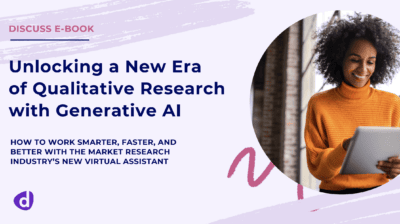The Discuss Guide to Online Qualitative Interviews

Supercharged by the digital transformation that has disrupted people’s lifestyles and buying behaviors, CX, insights teams and researchers have taken customer conversations online to meet people where they are, holding qualitative interviews to better respond to change. A new era of research and consumer intelligence has emerged, where qualitative interviews are aided by agile software with the power to unlock rich insights at scale.
Before diving into the technology behind online qualitative interviews — just what are they, exactly? And what are the advantages of conducting them online?
Qualitative interviews enable researchers to gather people’s subjective experiences, offering participants the opportunity to express opinions, beliefs and sentiments. Often referred to as “conversation with a purpose,” the approach is simple: to understand people, talk to more people. Unlike survey questions with predetermined responses, researchers can ask open-ended questions to hear customers using their own words, gaining deeper contextual data. Unlike quantitative research, which can only communicate the ‘what’ of customer or user behavior, qualitative interviews give researchers the freedom to explore the ‘why’ of a target audience’s behavior.
This approach also gives researchers the opportunity to ask follow-up questions to encourage longer and more authentic responses. As a result, insights gleaned from qualitative interviews are richer than quantitative feedback methods.
Qualitative interviews can take many forms, including:
- Focus groups: interviews that gather a small but demographically similar group of people to study their perceptions, opinions, beliefs, attitudes and reactions. This research method collects data through interactive and directed discussions facilitated by a skilled moderator. Focus groups are a staple of market research, and it is frequently used by marketers to learn about and test an idea, concept advertisement, product, packaging or service.
- In-depth interviews (IDIs): personal interviews with a single respondent.
- Dyads: interviews with two people. As an adjective, “dyadic” is used to describe their interaction. Dyads can provide rich insights into ethnography, as the two individuals could be associated (husband and wife, parent and child, two friends or co-workers). These are referred to as Known Pairs, and are the go-to choice if working with children or younger participants.

- Triads: interviews that involve three participants who may or may not know one another. Triads offer some of the advantages of focus groups and in-depth interviews in that the moderator can hone in on topics/subjects while also having a diversity of opinion.
To learn more about qualitative research methods, see our Glossary.
Online qualitative interviews expand a researcher’s reach beyond the geographic and accessibility limitations of in-person discussions, are more economical, and are further aided by automation software to speed the time-to-insights. Such interviews allow researchers to conduct more interviews and extract insights at scale, bringing structure to unstructured qualitative research. Researchers find that online qualitative interviews are:
- Cost Efficient: travel, facilities, recording fees and other costs are eliminated
- Faster: logistics such as recruitment, project management and reporting can be managed under one platform to cut down administrative burden
- Detail Rich: virtual conversations typically occur within a respondent’s home, giving a window into a person’s environment and allowing them to more easily recall habits, uses of certain products, and other key details of their experiences
Qualitative analysis is used to assess customer feedback when numbers fall short of painting a complete picture of the customer or user experience. While quantitative analysis is objective and deductive, qualitative analysis is subjective and inductive.
Below is a snapshot of just some of the ways that quantitative analysis differs from qualitative:
| Criteria | Quantitative | Qualitative |
| Purpose | Identify patterns and trends
Make predictions |
Understand people and their experiences |
| Data Types | Numbers
Statistics |
Words
Images |
| Type of Data Analysis | Statistical relationships | Features
Themes |
| Objectivity and Subjectivity | Objectivity is critical | Subjectivity is expected |
| Role of Researcher | Researchers and their biases are not known to participants in the study
Participant characteristics can be deliberately hidden from the research |
Researchers and their biases may be known to participants in the study
Participant characteristics may be known to the researcher |
| Final Report | Statistical report with correlations and comparisons | Narrative report with contextual description
Direct quotations from research participants |
How to Start a Qualitative Interview
Now that you have a foundational understanding of qualitative research, here are the the first steps that CX, UX and insights teams typically take before conducting qualitative interviews:
- Define a research objective
What is it that you ultimately need to know from your target audience? Are you going to use your time testing different messages, observing unboxing, or brainstorming for new concepts? Limit your objectives so that you have enough time to devote to the project and can adequately explore the topic. - Define target group(s)
Having identified objectives, who are the people best suited to give their opinions, beliefs and sentiments? Decide if current customers, non-users, lapsed customers, or even customers of your competitors are best suited to provide the most appropriate feedback.
- Build a discussion guide
Your discussion guide leads the research process and should provide a framework for unlocking the most authentic and important information. Think of this guide as a funnel that starts with broad category questions and continually narrows the focus to behaviors, attitudes, and specific questions.
To learn more ways to start qualitative research projects, see Co-Founder and Chief Strategy Officer Jim Longo’s tips in our post, “What Is Online Qualitative Research and How Is It Done?”
The Evolution of Online Qualitative Interviews
As previously noted, online qualitative interviews are now aided by software with the power to unlock rich insights at scale, giving structure to unstructured qualitative research. For example, videos can be transcribed through technology such as Machine Learning (ML), whereby key words and phrases can be tagged and grouped for quick reporting and sharing.
Innovations in qualitative analysis software have in turn enabled people’s experiences and voices to drive outcomes across an organization by nature of their scalability — and in turn shareability.
Through qualitative interview software like Discuss.’s platform, researchers can provide easily shareable video clips and highlight reels to bring their consumer research to life. Giving multiple stakeholders direct access to hearing people’s voices can validate hypotheses, illuminate key themes and sentiments, and inspire action to all members of an organization.
To learn more about how purpose-built platforms like Discuss have innovated to meet the evolving needs of researchers, read our post: “Online Qualitative Research Basics.”
Sign Up for our Newsletter
Related Articles

Unifying Insights: The Power of a Comprehensive Qualitative Research Repository
Explore the benefits of integrating live interviews, asynchronous activities, and off-platform research into a centralized research repository for streamlined analysis…
Explore the benefits of integrating live interviews, asynchronous activities, and off-platform research into a centralized research repository for streamlined analysis…

Qualitative Research Platforms: Top 8 Features and Considerations for Choosing the Right Partner
Insights for Selecting the Right Vendor to Drive Your Research Initiatives In the realm of market research, the choice of…
Insights for Selecting the Right Vendor to Drive Your Research Initiatives In the realm of market research, the choice of…

Top 4 Must-Haves of an All-in-One Qualitative Research Platform
Conduct human-centric qualitative market research at scale in a single, multifunctional platform In the ever-evolving landscape of market research, staying…
Conduct human-centric qualitative market research at scale in a single, multifunctional platform In the ever-evolving landscape of market research, staying…


